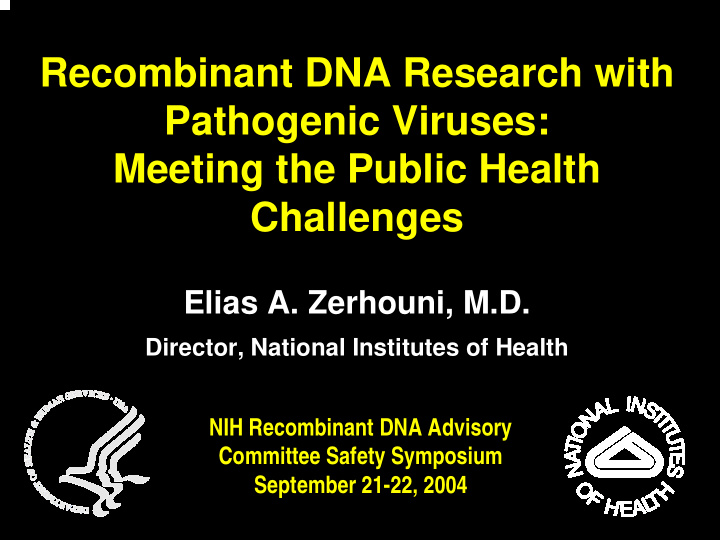



Recombinant DNA Research with Pathogenic Viruses: Meeting the Public Health Challenges Elias A. Zerhouni, M.D. Director, National Institutes of Health NIH Recombinant DNA Advisory Committee Safety Symposium September 21-22, 2004
Public Health Challenges Acute to Chronic Conditions Aging Population Health Disparities Emerging Diseases Biodefense
New Research on Emerging Infections: Challenges for Biosafety Review Increased research with pathogenic viruses • Improved methods for generation of recombinant viruses from plasmids • Public health concerns • Biodefense Examples of areas of research • 1918 “Spanish” Influenza Virus Highly Pathogenic Avian Influenza Viruses • • Severe Acute Respiratory Syndrome Coronavirus
Increasing NIAID Funding of Extramural Influenza Research 70 60 (in millions) 50 Dollars 40 30 20 10 0 FY02 FY03 FY04 est.
Public Health Impact of Influenza Virus • Novel viruses created each year by the high mutation rate and reassortment of genes among different viral strains – Virus escapes neutralization by antibodies to previous strains – No immunity from one year to the next
Public Health Impact of Influenza Virus Yearly epidemics • ~ 20,000 deaths/yr in U.S. Pandemics in the last century • 1918 H1N1 – ~ 675,000 deaths in U.S – 20 - 40 million world wide • 1957 H2N2 – ~ 66,000 excess deaths in US • 1968 H3N2 – ~ 34,000 excess deaths in US
1918 Influenza Virus Research • 1918 influenza virus RNA recovered from: US soldiers who died of the – Spanish flu during World War I British patients – – An Aleut woman who was buried in permafrost. • Sequence determined for 5 of 8 viral genes and ongoing for remaining virus.
Goals of Research on 1918 Influenza Virus • Determine virulence factors and molecular mechanisms for the high pathogenicity Image: Rutgers Univ. • Evaluate efficacy of vaccine candidates and antiviral drugs
Highly Pathogenic Avian Influenza Viruses • H5N1 • H7N7 – 1997 Hong Kong – 2003 Netherlands • 18 cases, 6 deaths • 79 conjunctivitis – 2003 Hong Kong • 13 influenza-like illnesses • 3 cases, 2 deaths • 1 death – 2004 Vietnam and Thailand • 3 person-to-person transmissions • 37 cases, 26 deaths • H9N2 – 1999 Hong Kong and China • 7 cases – 2003 Hong Kong – 2 cases
Highly Pathogenic Avian Influenza Viruses • Source of next pandemic? • Reassortment with a human influenza virus or direct infection from birds (H5N1) and adaptation to transmit efficiently from person to person?
SARS Coronavirus • Novel coronavirus was the causative agent of the SARS outbreak in 2002- 2003 in which ~ 8000 individuals were infected and ~ 800 deaths occurred. • The sequence of the ~ 30,000 nt RNA genome was determined within two months of viral isolation.
Public Health Goals of Research on SARS Coronavirus • Determine functions of viral protein’s role in virulence • Develop rapid diagnostic assays for clinical SARS • Develop live attenuated virus vaccine candidates • Identify targets for antiviral drugs
Biosafety and Public Health • Research into viral virulence mechanisms and the development of vaccines and antiviral drugs are public health priorities. • While this research is of critical importance, it is equally important that the research be performed responsibly to protect the health of laboratory researchers and the public.
Standards of Biosafety Practice • Established: – NIH Guidelines for Research Involving Recombinant DNA Molecules – Biosafety in Microbiological and Biomedical Laboratories • Needed: – Interpretation and application of biosafety principles to new rDNA research areas
Goals • Enhance awareness of the critical safety issues • Promote a “culture of responsibility” • In light of new methodologies, develop guidance for rigorous biosafety review and appropriate biologic and physical containment.
Recommend
More recommend